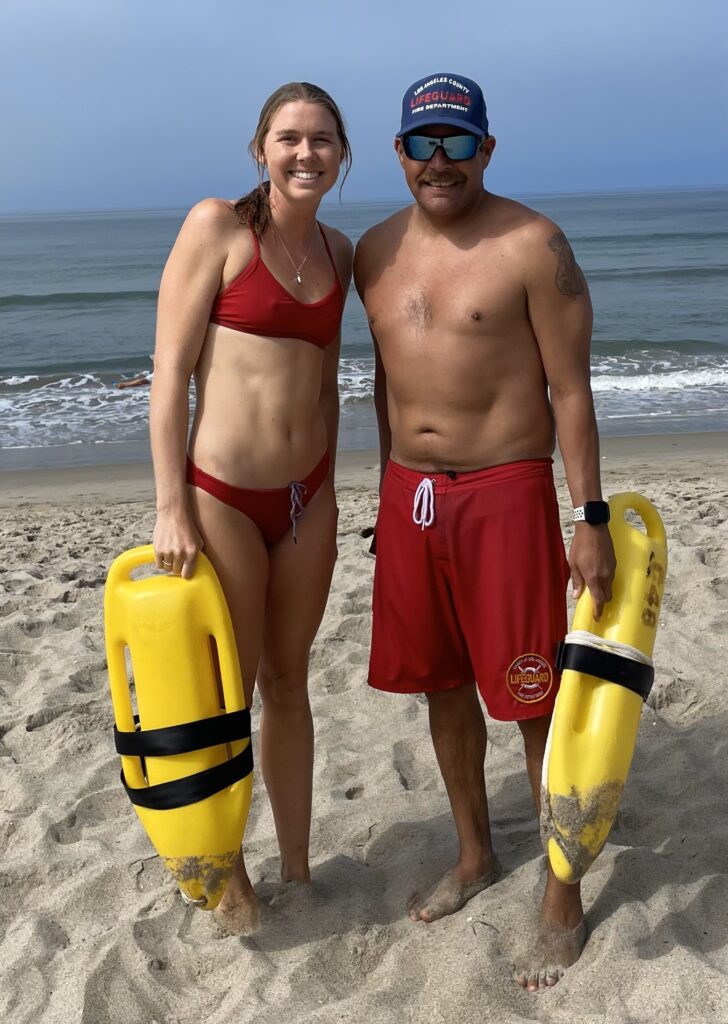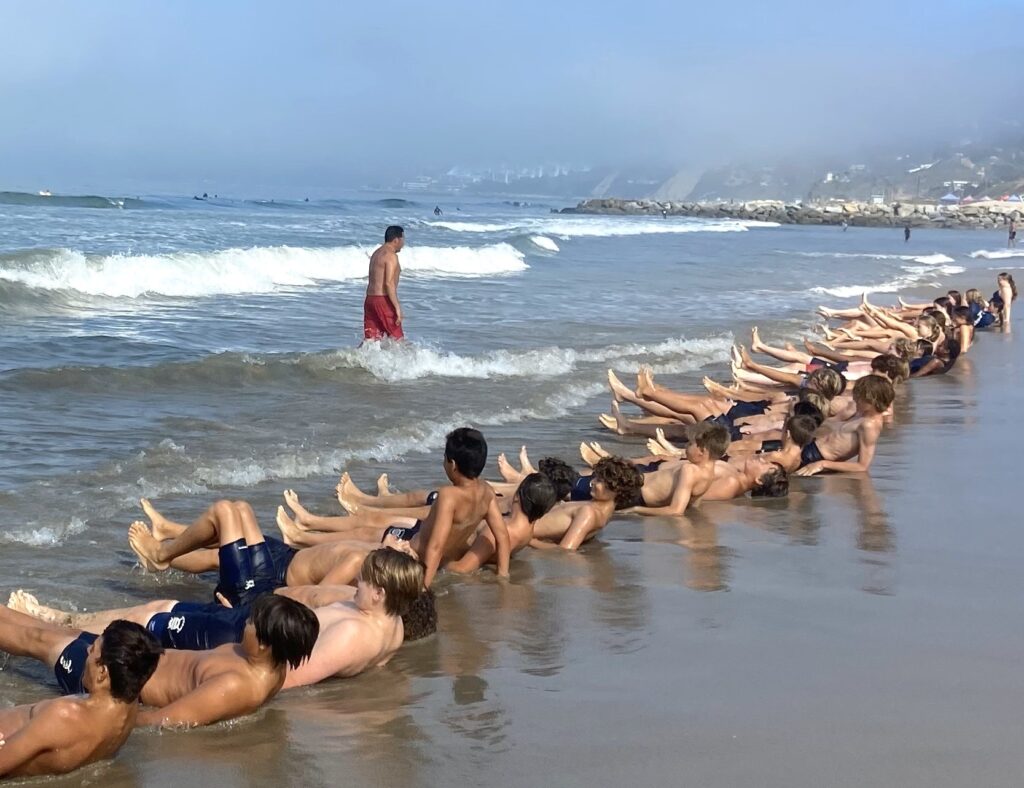(Editor’s note: My three adult children participated in L.A. County Junior Life Guard program. When the YMCA pool was still in upper Temescal and my children were young, a wise mother told me about Guards. She said that her kids, who were teens, although not pleased about doing the program, were signed up. “I told them if they ever want to go to the beach without their mom, they needed to take Junior Lifeguards,” she said. “They learn how to be safe in the ocean.”)
Many Pacific Palisades residents are using summer vacation time to go to far away destinations in Peru, Italy or Asia. Los Angeles Police Office, Brian Espin selected a closer vacation locale, Will Rogers Beach.
Espin, Pacific Palisades’ Senior Lead Officer, planned his vacation so he could work as an instructor for the L.A. County Junior Lifeguard program.
The first session of the Junior Guard program ran from June 19 to July 14.
Espin was on the sand by 8 a.m., where he welcomed his group, the B-group (ages 12-13).
When his two-week LAPD vacation time had been used, he did double shifts. He left the beach by 12:30 p.m., went to the West L.A. Police Station, and worked until 10-10:30 p.m. or worked weekends.
CTN met the police officer when he was on duty in the Palisades on July 12. He was asked why he wanted to give up his vacation to instruct 12-13-year olds. “I really enjoy doing this,” he said.
Espin became an L.A. County Lifeguard in 2001. He ran the Venice Junior Guard program in 2003 and 2004.
Then, he was hired by LAPD in 2005, and became a full-time police officer.
He continued to be a lifeguard at local beaches on his days off for the next 18 years.
“It’s satisfying,” he said, noting that he still works as lifeguard, between 10 to 20 days every summer, depending on his schedule.
During that time, he has also subbed as a teacher for Junior Guards. But this is his first full class since 2004.
For those who have never had children in the program, it is open for ages 9 through 17. The JG mission is to educate youth in ocean and beach safety, while working on physical conditioning, basic first aid and environmental awareness. And possibly, get kids interested in becoming lifeguards. There is a minimal cost for the four-week program.
Kids are divided into three groups the A’s (ages 14-15), the B’s (ages 12-13) and the C’s (ages 9-11).
To participate, kids need to be able to swim the 100-yard freestyle in a prescribed time. Every day, kids generally do a buoy swim in the ocean, so it’s necessary to have swimming skills.
“Will Rogers is known to have good swimmers,” said Espin, who decided to be one of the instructors this year, because his son is in guards. Traffic/commuting-wise, it made more sense for Espin to stay on the beach rather than drive back and forth to his home in the valley.
His son, who is in the B-group “wanted me to be an instructor for either the A or C group,” Espin said, but unfortunately, neither father nor son had a choice.
“Instructors from prior years have priority,” he said. If there is an opening that’s where new instructors are slotted in. “Both instructors from the B group left after last year.”
On a typical day, after an ocean swim around a buoy, kids run races on the sand. They play “flags,” a game like musical chairs where they race to grab a stick in the sand, and most recently there’s “water flags.” Kids lie down on the sand, instructors send tennis balls into the water (less balls than kids) and the guards have to run to the edge of the water, dolphin through the waves, capture a ball and bring it back to shore.
Several competitions are held against fellow beaches, Will Rogers hosted Zuma and Santa Monica last week. “My group was first in swimming, second in the run and third in paddling,” Espin said.
The first session ends tomorrow July 14, with the granddaddy of all relays: the Taplin Relays. Held at Dockweiler Beach in Playa del Rey, participants from the Junior Guard programs in Avalon, Catalina, Cabrillo, Torrance, Redondo, Hermosa, Manhattan Beach, El Segundo, Venice, Santa Monica, Will Rogers and Zuma, compete.
Instructors select an 18-person team that consists of six runners, six paddlers and six swimmers. Teams from each beach race against each other in a relay format. All runners must finish and then tag off to the paddlers, who when they have finished, tag the swimmers. At the end of the race, all participants form a nearly 200-person “tunnel of love,” to welcome the last person back to the beach.
The progress of the race can be tracked by the color of the caps the youth wear during the relays. Each beach is given a specific color.
There are financial aid scholarships available, and the Los Angeles County Fire Department encourages participation of those with limited access or opportunity.
“It’s important kids learn to be safe at the beach and how to identify ocean conditions,” Espin said. “We teach them ‘smart swimming.’”
Basic first aid is also taught, and Espin spoke about two youth who were able to revive their father through CPR. When asked where they learned it, they said, “at guards.”
After meeting with CTN, Espin was headed to the Palisades Recreation Center. “There are seven locations that are problematic here and that is number one,” he said.



